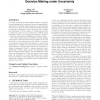Free Online Productivity Tools
i2Speak
i2Symbol
i2OCR
iTex2Img
iWeb2Print
iWeb2Shot
i2Type
iPdf2Split
iPdf2Merge
i2Bopomofo
i2Arabic
i2Style
i2Image
i2PDF
iLatex2Rtf
Sci2ools
ATAL
2015
Springer
2015
Springer
Human Behavior Models for Virtual Agents in Repeated Decision Making under Uncertainty
To design virtual agents that simulate humans in repeated decision making under uncertainty, we seek to quantitatively characterize the actual human behavior in these settings. We collect our data from 800 real human subjects through a large-scale randomized online experiment. We evaluate the performance of a wide range of computational models in fitting the data by both conducting a scalable search through the space of two-component models (i.e. inference + selection model) and investigating a few rules of thumb. Our results suggest that across different decision-making environment, an average human decision maker can be best described by a two-component model, which is composed of an inference model that relies heavily on more recent information (i.e. displays recency bias) and a selection model which assumes cost-proportional errors and reluctance to change in subsequent trials (i.e. displays status-quo bias). Additionally, while a large portion of individuals behave like the ave...
| Added | 16 Apr 2016 |
| Updated | 16 Apr 2016 |
| Type | Journal |
| Year | 2015 |
| Where | ATAL |
| Authors | Ming Yin, Yu-An Sun |
Comments (0)

